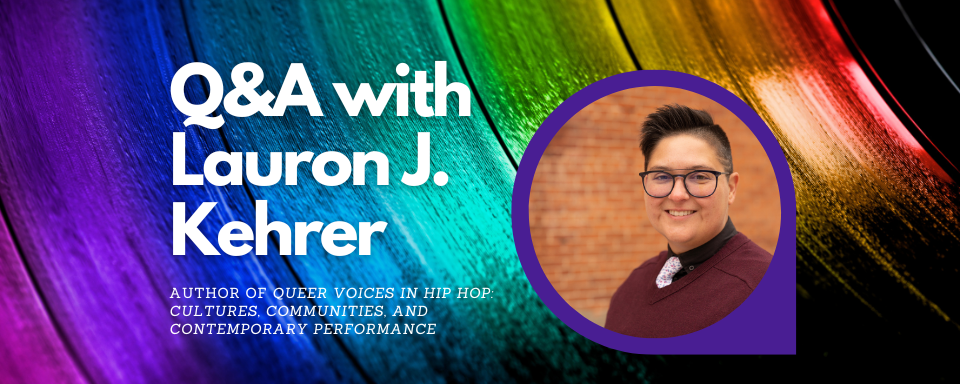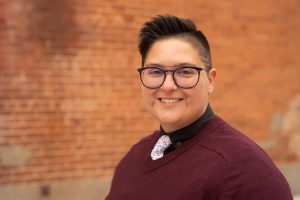Q&A with "Queer Voices in Hip Hop" Author Lauron J. Kehrer

This guest author post is a Q&A with Lauron J. Kehrer, author of Queer Voices in Hip Hop: Cultures, Communities, and Contemporary Performance , from the University of Michigan Press. This book is available in hardcover, paper, and open access.
What surprised you the most while conducting your research for the book?
I don’t think surprised is the right word, but I was constantly realizing that there is a real lack of scholarly attention to Black queer and trans communities in music scholarship specifically, and in cultural studies more generally. Most scholarship on queerness in popular music has focused on white artists and audiences, and most studies of hip hop and other Black music genres, even those that talk about gender, have not given adequate attention to LGBTQ practitioners. This is not necessarily surprising, but it does mean that Black queer contributions have been underdiscussed. I am interested in seeing more work that positions Black queer and trans people not as marginal to communities or social movements, but as centered within them. Additionally, I don’t think we discuss the continuities of Black queer cultural practices across periods of time — when these practices do get attention, it’s at specific historical moments or through particular figures. This sometimes made it challenging for me to fill in historical connections and to make clear the Black queer musical lineages of which hip hop is a part.
What made you dive into analysis of not only hip-hop, but house and dance music early on in the book?
For similar reasons as I noted above, I really wanted to demonstrate some Black queer cultural continuities as they manifest in these genres during the late twentieth century. I think there are distinctive musical ties between disco, house, and hip hop, but those musical ties underscore social ties between queer and presumably non-queer spaces and social spheres. Because it is very challenging to identify many openly queer hip hop pioneers from the genre’s earliest iterations, I leaned into those musical and social connections to situate queerness at the genre’s origins. I really do believe that without the musical innovations of Black queer practitioners that are visible and audible in house and other dance music genres, hip hop would not have developed in the way that it did.
A number of openly queer and trans artists use musical signifiers of these dance music genres to articulate a queer subjectivity. In order to make this argument, I had to dig into where those signifiers originated, linking the present with the past.
Why was it so important to discuss femininity, masculinity, and Bailey’s six identified gender categories when it came to ballroom culture, and how does this connect to hip-hop?
There is a particular kind of normative Black masculinity that has become a hallmark of mainstream hip hop, even though it has been challenged by rappers of various genders. Hip hop femininities, too, are often in conversation with that ideal of masculinity. There are, however, rappers who are more expansive in their gender expressions and identities. In the chapter on New York City-based rappers who draw on Ballroom culture, I explore how Bailey’s gender categories, which are visible within that culture but might not be visible in a broader, heterocentric hip hop framework, are employed. Really, I’m pointing to other Black and Latinx queer practices to make clear that genders and gender expressions that might read as outliers in hip hop are actually very well-established in Black queer communities — as audiences, we need to be open to other frameworks that make visible these identities and expressions.
Scholars have been grappling with how gender is expressed in hip hop for a long time, but mostly focused on how women rappers navigate hip hop’s gender norms. I am interested in breaking out of a binary gender approach to the genre, and thinking about other gender possibilities that are already present.
What does centering the performances of openly queer and trans artists of color reveal about their role in the development of hip hop?
The answer is in the question — this centering demonstrates that openly queer and trans artists of color are not marginal, but really are integrated into the very fabric of hip hop. While I am focused on more contemporary artists who have experienced a period of unprecedented commercial success and visibility, I hope that I have also shown that these artists have important predecessors. We might not always know the names of the queer and trans practitioners from the earliest decades of the genre, but we can see how hip hop spheres and queer spheres overlap in a way that guarantees there has always been queer involvement in hip hop. The musical influences of Black queer artists are apparent.
For readers who want to listen to some of the music you talk about in the book, are there specific songs you would recommend?
There are so many songs! For starters, Zebra Katz’s “Ima Read,” anything by Big Freedia (perhaps check out “Explode” before returning to Beyoncé’s “Break My Soul”), Young M. A’s “Ooouuu,” Leif’s “Wut,” and, of course, Lil Nas X’s “MONTERO (Call Me By Your Name).”
Check out a playlist inspired by the book here: https://open.spotify.com/playlist/11p8zcVTNIGwu4Z007Ziuo
What do you hope readers will take away from reading Queer Voices in Hip Hop?
I hope that readers will no longer think of openly queer and trans artists in hip hop as the exception, or as anomalies. Instead, I hope they will make connections between hip hop as a Black queer musical practice and other music genres and cultural practices. I also hope to have challenged the notion that hip hop is always homophobic — while I don’t discount the very real homophobia that some artists espouse, I do not believe there is anything innately homophobic about the genre. Instead, I hope we question the erasure of LGBTQ practitioners that have helped to shape hip hop from its earliest iterations, and connect those queer roots with hip hop’s queer present.




